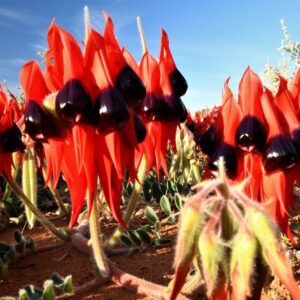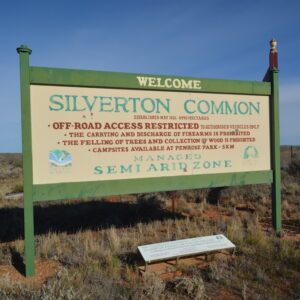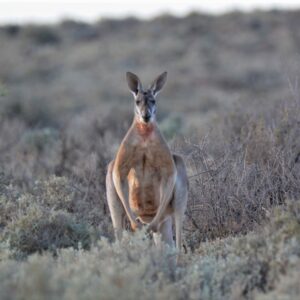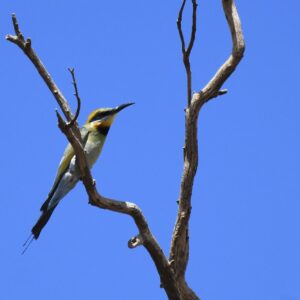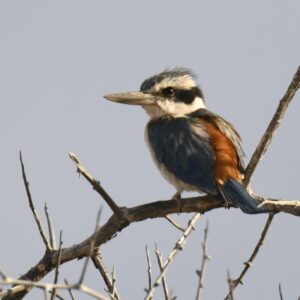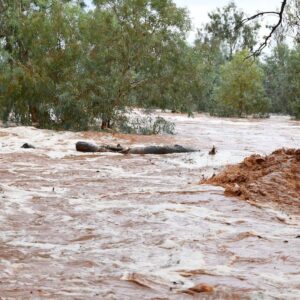Environment
Silverton's Environment
Silverton is situated in a very special part of the world. It has an amazing environment, including the flora and fauna, the waterways, skies and geology. Silverton certainly meets the criteria for droughts and flooding rains and extreme temperatures and is home to some special species of plants and animals, some of which are threatened. Sadly, Australia has the worst record in the world for extinct species, so we are very aware of and protective of what we have here. The people of Silverton are working closely with local Landcare and Field Naturalist groups to identify and record the flora and fauna of the Silverton area and taking steps to protect them.
Silverton’s tree species include the huge Silverton Red Gums (Eucalyptus camaldulensis var obtuse) which grow along our creeks and waterways, Mulga (Acacia aneura) and the more familiar acacias we know as wattle, with their beautiful golden flowers in spring, just to name a few.
Some of the more common shrubs you will see in the area are various species of Saltbush and Bluebush (Chenopodiaceae). These species are seen in open areas where there are few trees. They hold the soil together, helping to prevent erosion and providing food for grazing animals. They are also home to species of Fairy Wrens and other small birds. Many people are familiar with Old Man Saltbush that was introduced to feed the camels which were a mode of transport in the early days. This saltbush has larger leaves and is often used for hedging on properties as it makes a great windbreak and offers protection from the elements for other species.
Eremophila, or Emu Bushes are well represented in the Silverton area. Eremophila means “desert-loving” and there are 214 species spread across inland Australia. Emu Bushes come in all shapes, sizes and colours and have distinctive tube-shaped flowers. Eremophila has become a popular garden plant as they require little water or fertiliser and are very attractive to both humans and wildlife.
There are many species of wildflowers in this area. The most sought-after is the Sturt’s Desert Pea. The “Sturt Pea” can spread over a very large area and comes in various colours. Please be aware that the Sturt’s Desert Pea is a protected species and you must not pick the flower or dig up the plant. It goes without saying that this is the case for all our wildflowers. Take a photo and enjoy the moment.
Sturt Pea and other native flower seeds are available for purchase at most garden centres.
There are more species of birds and animals in the Silverton area than can be mentioned here. You will probably see Red Kangaroos (Macropus Rufus), Grey Kangaroos and possibly Euros, which are a hill-dwelling kangaroo. There are also echidnas in the area, many species of lizard such as the shingleback, bluetongue, bearded dragon, goannas and species of skinks and geckos. The creeks are home to burrowing frogs and when the creeks fill with water, the frogs create quite a chorus at night time. Our trees provide roosts and nest sites for birds and bats, so please do not cut down dead trees for firewood. The tree itself may be dead, but it will certainly be home to more living creatures than you can imagine. The same is true for fallen timber. Branches and logs on the ground provide protection and food sources for many species of wildlife. Echidnas feed on the ants and grubs which live beneath fallen timber. Bats roost in this timber, which is also home to lizards, snakes, spiders, ants and many, many other life forms. For these reasons, cutting and collecting firewood is not permitted.
If you are a bird watcher, you won’t be disappointed. Silverton is home to hundreds of bird species. You may see Rainbow Bee Eaters along the creeks. These birds nest in burrows in the creek banks and are, as their name suggests, beautifully coloured. You will no doubt see our cheeky larrikins of the Outback, the Pink and Grey Galah and the white Corella (both cockatoos). Cockatoos nest in the hollows of gum trees and can often be observed coming and going from their nests. Bronze-winged Pigeons, Crested Pigeons, Willy Wagtails, Magpies, Butcher Birds, Wrens, Finches, Honeyeaters, Parrots and so many other surprises await visitors to Silverton. Bring along your binoculars, bird book and camera and enjoy.
If you are up early, make sure you watch the sunrise and at the end of the day, relax and watch the sunset…we have the most beautiful skies.
THE SILVERTON COMMON
The Silverton Common is all the vacant land you see around Silverton starting at the cattle grid and has existed for over 115 years. It was originally much larger than its’ current 12,000 acres and was established for the keeping of residents milking cows and goats and also for teams of bullocks, donkeys and camels which were regularly used as transport for goods to and from the area. The Common is still home to some stock today, with each owner (Silverton residents) paying a fee per head of cattle or horses. Stock roams freely, so keep an eye on the road while driving!
The Common is a Crown Reserve, managed by the Silverton Temporary Common Trust. Fees from keeping stock on the Common are used to maintain fences, cattle yards and watering points, for managing weed species and protecting native flora and fauna. Musters are held regularly to keep a check on the numbers and condition of stock. Stock numbers are reduced in times of drought or adverse conditions.
TEMPERATURES FOR SILVERTON
Silverton has hot summer temperatures. The summer average high temperature for Silverton is approximately 31 °c. Be aware that temperatures regularly reach 40°c and over. The summer low temperature is approximately 19 °c.
Silverton has mild winter temperatures. The winter average high temperature for Silverton is approximately 15 °c. The winter low temperature is approximately 7 °c. Be aware that overnight temperatures can often be as low as 2°c or 3° c and does fall below zero on occasions with frost not uncommon.
MONTH | LOW degrees Celsius | HIGH degrees Celsius |
|---|---|---|
January | 19 | 32 |
February | 20 | 32 |
March | 17 | 28 |
April | 13 | 23 |
May | 10 | 19 |
June | 7 | 15 |
July | 6 | 14 |
August | 8 | 17 |
September | 10 | 21 |
October | 13 | 25 |
November | 16 | 28 |
December | 18 | 31 |
REMEMBER
- Wear a hat and sunscreen when walking
- Make sure you carry water with you
- Wear clothing appropriate to the weather and wear sturdy shoes/boots
- Bring your paints and easel or sketch pad and pencils
- Bring your camera
- Bring your bird book and binoculars
- Camping is not permitted on the Common, including along the creeks. Visitors are encouraged to use the facilities at Penrose Park.
- Removal of Firewood is not permitted from the creeks or Silverton Common.
- Dirt tracks on the Common are for local access only.
4WD-ing and riding motor bikes in Silverton’s Creeks and on the Common is NOT PERMITTED. Eldee Station just north of Silverton offers recreational 4WD tracks and accommodation. Eldee Station may be contacted on 08 8091 2578

